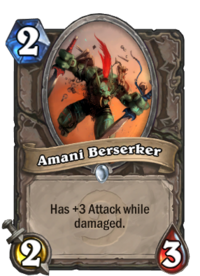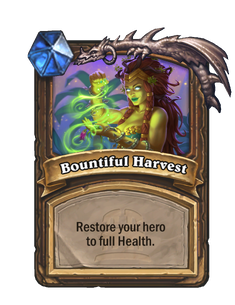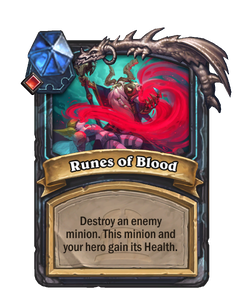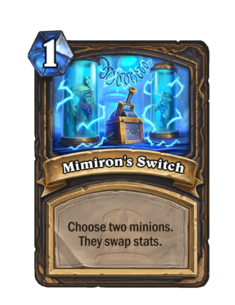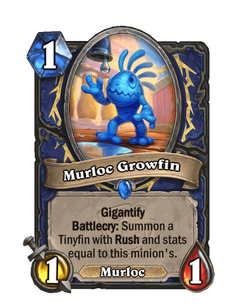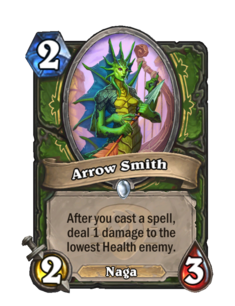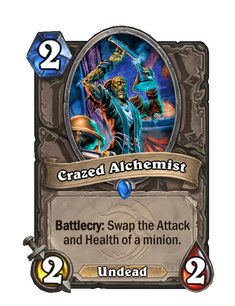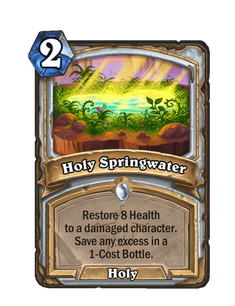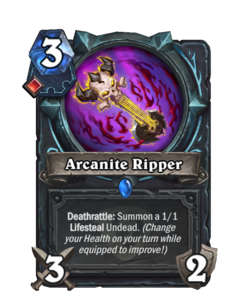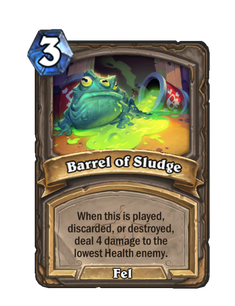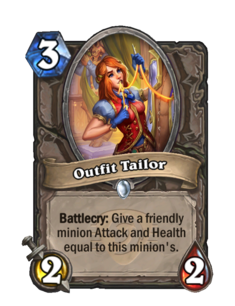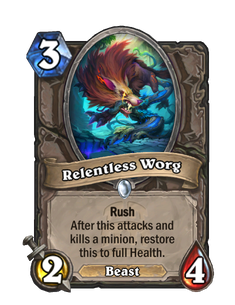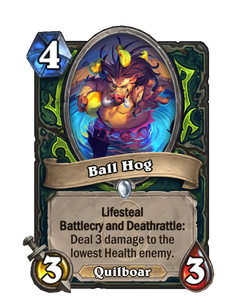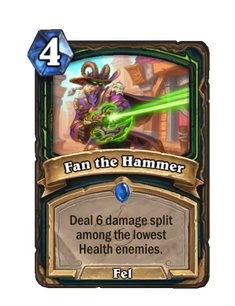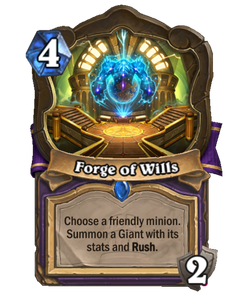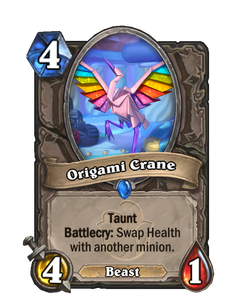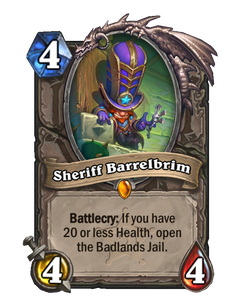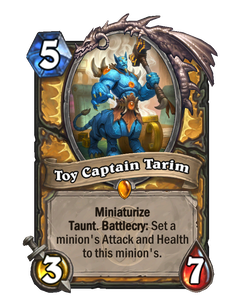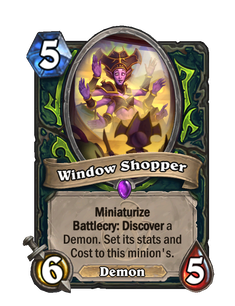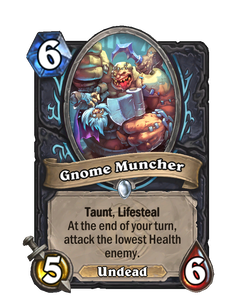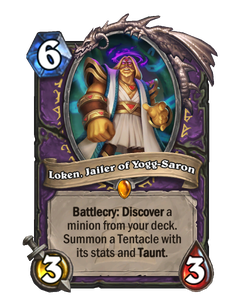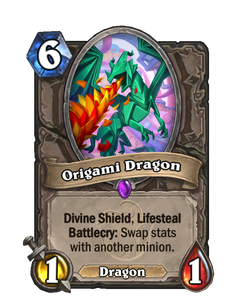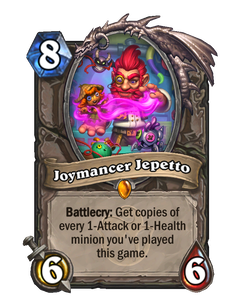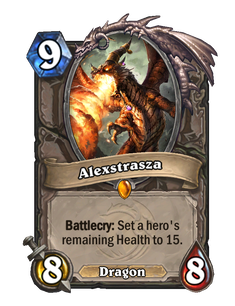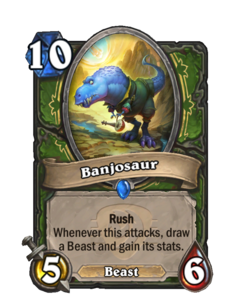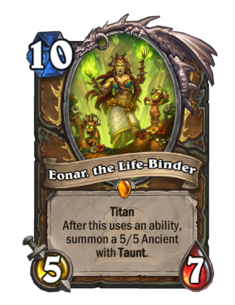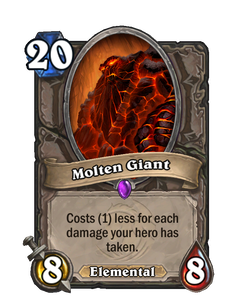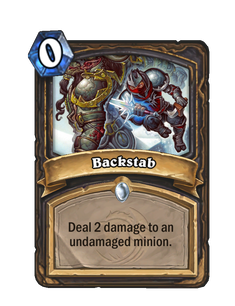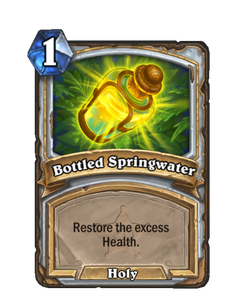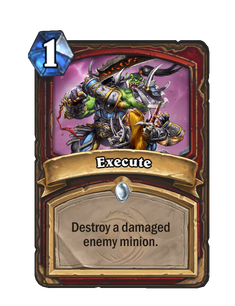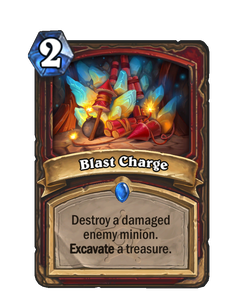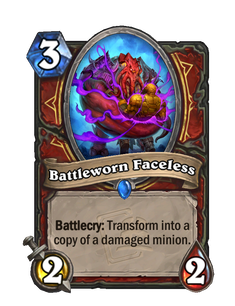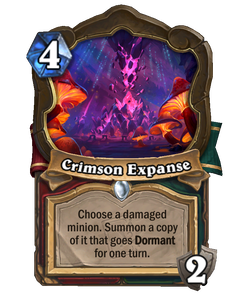Health
Health, sometimes referred to as life, hit points or HP, is an attribute found on heroes and minions, reflecting the remaining survivability of the character. Health can be reduced, almost always by taking damage. If a character's Health is reduced to 0 (or lower) that character will be destroyed. All standard heroes start off with 30 Health. A hero's maximum Health value can be changed with certain cards. However, Armor can be used to protect a hero's Health from damage, for a total "effective Health" greater than the hero's maximum.
Health is displayed at the bottom right corner of each character's card or portrait, set against a red drop of blood.
Details[edit | edit source]
Health is divided into two separate stats: the character's current Health, and their maximum Health. A character is said to be "at" their current Health. The term Health usually refers to a character's current Health.
Characters at maximum Health have their Health value displayed in white, while those below maximum Health have it displayed in red. Characters below maximum Health are considered "damaged", which can enable certain effects (see below). Each character enters play at maximum Health.
Characters can lose current Health by taking damage from various sources, primarily combat, spells and Hero Powers. Unlike in some other games, Health is persistent, and does not automatically regenerate. Characters that are damaged do not heal by themselves. However, numerous abilities exist to ![]() Heal characters, such as
Heal characters, such as ![]() Lesser Heal,
Lesser Heal, ![]() Voodoo Doctor and
Voodoo Doctor and ![]() Lay on Hands. Healing effects increase a character's current Health, but cannot increase it beyond their maximum Health. Additionally,
Lay on Hands. Healing effects increase a character's current Health, but cannot increase it beyond their maximum Health. Additionally, ![]() Alexstrasza changes the current Health of a player to 15, which does not count as healing or damage despite having a similar effect.
Alexstrasza changes the current Health of a player to 15, which does not count as healing or damage despite having a similar effect.
Maximum Health is not altered by taking damage, but can be reduced through other means, such as ![]() Hunter's Mark and
Hunter's Mark and ![]() Equality. Various effects can increase a minion's maximum Health, which will also increase their current Health by the same amount, without technically healing them. Examples include
Equality. Various effects can increase a minion's maximum Health, which will also increase their current Health by the same amount, without technically healing them. Examples include ![]() Divine Spirit,
Divine Spirit, ![]() Blessing of Kings and
Blessing of Kings and ![]() Stormwind Champion's ongoing effect. For details on how enchantments can affect current and maximum Health, see below. Transform effects set all attributes to predetermined values, which could result in current and/or maximum Health increases, decreases, or neither. The hero equivalent to transformation is replacement, which similarly could result in a Health change (usually a decrease). Alexstrasza has a unique effect on maximum Health of heroes as well: In the rare case a hero (currently, only the Ragnaros replacement hero) has less than 15 maximum Health, Alexstrasza sets that Hero's maximum Health to 15 alongside its current Health. None of the maximum Health-related effects in this paragraph count as damage or healing, even if they also add or remove "current" Health.
Stormwind Champion's ongoing effect. For details on how enchantments can affect current and maximum Health, see below. Transform effects set all attributes to predetermined values, which could result in current and/or maximum Health increases, decreases, or neither. The hero equivalent to transformation is replacement, which similarly could result in a Health change (usually a decrease). Alexstrasza has a unique effect on maximum Health of heroes as well: In the rare case a hero (currently, only the Ragnaros replacement hero) has less than 15 maximum Health, Alexstrasza sets that Hero's maximum Health to 15 alongside its current Health. None of the maximum Health-related effects in this paragraph count as damage or healing, even if they also add or remove "current" Health.
Health can be reduced to below 0. Usually this has no consequence, since any character with Health at or below 0 will be destroyed, but when multiple effects alter a character's Health during the same event phase, this can allow other effects to increase the character's Health back to a positive number, thus preventing the character from being destroyed. For more information, see Advanced rulebook.
Some minions have an unusual relationship with their Health value. For example, ![]() Lightspawn's Attack is always equal to its Health, allowing abilities such as Divine Spirit to increase its Attack, and any damage taken to decrease its Attack accordingly.
Lightspawn's Attack is always equal to its Health, allowing abilities such as Divine Spirit to increase its Attack, and any damage taken to decrease its Attack accordingly.
Related cards[edit | edit source]
- For Wild format listings, see Health/Wild format.
While numerous cards can affect a character's Health, certain cards have a specific synergy with a character's Health value.
Damaged status[edit | edit source]
If a character's Health value is reduced below its current maximum, it is considered 'damaged', and its Health value will be displayed in red. Restoring a character's current Health to its maximum will cause it to lose damaged status.
The damaged status is used in numerous card mechanics. Most notably, Enrage effects only take effect when a minion is damaged; healing it back to full health will cancel the effect. Cards such as ![]() Execute and
Execute and ![]() Rampage require damaged targets, while
Rampage require damaged targets, while ![]() Backstab and
Backstab and ![]() Shadow Strike requires undamaged targets. Damaged status may be a liability or a boon, depending on the minion and the player. Warriors have many cards that benefit from the presence of damaged minions, both allied and enemy.
Shadow Strike requires undamaged targets. Damaged status may be a liability or a boon, depending on the minion and the player. Warriors have many cards that benefit from the presence of damaged minions, both allied and enemy.
When a minion's maximum Health is increased by effects, it is possible for a minion to be considered damaged despite having far more Health than its original maximum. By lowering the minion's maximum Health, losing a Health-increasing enchantment (or gaining a Health-reducing enchantment) can also act to restore a damaged minion to undamaged status.
Related cards[edit | edit source]
- For Wild format listings, see Health/Wild format.
Below are listed cards with a specific relationship to the damaged status. For other effects activated by taking damage, see Enrage and triggered effect.
Enchantments[edit | edit source]
The basic process of dealing and receiving damage is simple: the appropriate number of points are deducted from the character's current Health value. However, the interactions between health, enchantments and damage are a little more complex.
The key underlying design is that any time a minion's maximum Health is increased, its current Health is increased by the same amount. A 1/1 minion gaining +1 Health becomes a 1/2. There is no distinction between a minion's 'natural' Health and Health granted through enchantments.
However, when a minion's maximum Health is reduced, its current Health is only reduced if it exceeds the new maximum. If a minion's current Health does not exceed the new maximum, it will not be reduced. Losing current Health due to a reduced maximum Health does not count as damage.
One consequence of this design is that +Health enchantments can at times act like heals. Example: A 2/2 minion takes a point of damage, making it a damaged 2/1. It then gains a +1 Health enchantment, making it a damaged 2/2 with a maximum Health of 3. The enchantment is then removed, leaving it as an undamaged 2/2. The enchantment, although temporary, effectively gave the minion a permanent +1 Health effect, and also served to remove the minion's damaged status.
This design makes the order of damage and enchantment removal strategically significant. Specifically, when a minion's current Health exceeds its natural maximum, it makes it far more effective to remove a minion's Health enchantments before attacking it. Example: A 2/1 minion is granted a permanent +1/+1 enchantment, making it a 3/2. Option A: The player deals 1 point of damage to the 3/2, making it a damaged 3/1, then silences it, leaving an undamaged 2/1. Option B: The player silences the minion, making it a 2/1, then deals 1 point of damage to the minion, destroying it. Note that buffs granted by other minions' on-going auras cannot be removed by silencing the buffed minion; only neutralising the aura minion itself will remove the buffs from the affected minions.
Note that while most increases to a minion's Health occur through gaining enchantments, they can also come from removing enchantments such as ![]() Equality and
Equality and ![]() Hunter's Mark which lower Health. For example, if a 5/5
Hunter's Mark which lower Health. For example, if a 5/5 ![]() Stranglethorn Tiger is reduced to 1 Health, affected by Equality, then silenced, the result will be a full Health 5/5 Stranglethorn Tiger.[1] Regardless of the cause, any adjustment to a minion's maximum Health follows the same rules.
Stranglethorn Tiger is reduced to 1 Health, affected by Equality, then silenced, the result will be a full Health 5/5 Stranglethorn Tiger.[1] Regardless of the cause, any adjustment to a minion's maximum Health follows the same rules.
For more information on Health and enchantments, see Advanced rulebook.
Strategy[edit | edit source]
A common tactical point regarding Health is that Health is simply a resource, to be used to progress the player's position within the game. While losing Health can generally be regarded a bad thing, in many cases it is possible to sacrifice Health in order to gain advantage, to protect from future damage, or to keep friendly minions in play. If the player is too concerned about taking damage, they may make bad compromises in order to retain their Health, while slowly giving away the game.
The use of weapons and ![]() Shapeshift are good examples of where the hero's Health can be traded for board advantage to great effect, while the warlock hero power
Shapeshift are good examples of where the hero's Health can be traded for board advantage to great effect, while the warlock hero power ![]() Life Tap allows the hero to directly trade Health for card advantage. Weapons can also provide card advantage, by using a single weapon card to clear multiple minions - at the cost of the hero's Health, of course. While some situations will provide the opportunity for excellent trades, in others it is a simple exchange of Health for the removal of a threatening minion. It is generally preferable to suffer a minion's Attack in damage once in order to remove the minion, rather than allow it to repeatedly attack the hero thereafter. The hero can sacrifice their Health in exchange for the Health of their minions, making for a stronger position on the board.
Life Tap allows the hero to directly trade Health for card advantage. Weapons can also provide card advantage, by using a single weapon card to clear multiple minions - at the cost of the hero's Health, of course. While some situations will provide the opportunity for excellent trades, in others it is a simple exchange of Health for the removal of a threatening minion. It is generally preferable to suffer a minion's Attack in damage once in order to remove the minion, rather than allow it to repeatedly attack the hero thereafter. The hero can sacrifice their Health in exchange for the Health of their minions, making for a stronger position on the board.
Health only becomes more than a resource when it is exhausted completely, losing the player the game. However, the point at which Health begins to become a concern is a highly debatable point. Decks such as nuke and aggro decks, using spells like ![]() Pyroblast and
Pyroblast and ![]() Unleash the Hounds, can quickly burst the hero's Health a dozen points or more in a single turn. For this reason, below a certain point it is considered risky to lower the hero's Health any further. Aggro and nuke decks rely upon lowering the hero's Health within a relatively short timeframe, and may count on the player trading their Health for board advantage - allowing the hero to be defeated before they have time to capitalise on their apparent board or card advantage.
Unleash the Hounds, can quickly burst the hero's Health a dozen points or more in a single turn. For this reason, below a certain point it is considered risky to lower the hero's Health any further. Aggro and nuke decks rely upon lowering the hero's Health within a relatively short timeframe, and may count on the player trading their Health for board advantage - allowing the hero to be defeated before they have time to capitalise on their apparent board or card advantage.
Over all, consider Health a useful commodity which can often be traded for board advantage, and which only becomes important to conserve once it reaches critical levels. Knowing when to sacrifice it and when to conserve it is a key skill, especially important for weapon classes, druids and warlocks.


